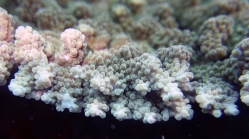WoRMS name details
Acropora irregularis (Brook, 1892)
206993 (urn:lsid:marinespecies.org:taxname:206993)
unaccepted > junior subjective synonym
Species
marine, fresh, terrestrial
(of Madrepora irregularis Brook, 1892) Brook G (1892) Preliminary descriptions of new species of Madrepora in the collections of the British Museum. Part II. Annals and Magazine of Natural History 10: 451-465. [details]
Description A magnificent and large Acropora, reaching a metre or more in height and breadth. Main branches sweep upwards, often...
Description A magnificent and large Acropora, reaching a metre or more in height and breadth. Main branches sweep upwards, often reversing direction sharply. Lateral fusion of smaller side branches causes branch ends to become spade like, and further fusion may even lead to the development of semi-circular funnel shaped structures. It has been confused with Acropora pharaonis, but mainly because both are of similar and large size. A. pharaonis has tapering main branches, while A. irregularis does not - indeed the fusion of the many smaller branches forms thickening spade-like structures at the ends of branches. A. irregularis is more like a smaller version of the Caribbean elk-horn coral, A. palmata. A. stoddarti is also large and possibly confused with A. Irregularis. Pillai & Scheer 1976 provide a redescription. Given its impressive size, Brooks name (probably done from fragments) is unfortunate! (Sheppard, 1998). [details]
Hoeksema, B. W.; Cairns, S. (2024). World List of Scleractinia. Acropora irregularis (Brook, 1892). Accessed through: World Register of Marine Species at: https://www.marinespecies.org/aphia.php?p=taxdetails&id=206993 on 2024-05-01
Date
action
by
2000-09-28 07:24:50Z
changed
Garcia, Maria
![]() The webpage text is licensed under a Creative Commons Attribution 4.0 License
The webpage text is licensed under a Creative Commons Attribution 4.0 License
original description
(of Madrepora irregularis Brook, 1892) Brook G (1892) Preliminary descriptions of new species of Madrepora in the collections of the British Museum. Part II. Annals and Magazine of Natural History 10: 451-465. [details]
context source (Hexacorallia) Fautin, Daphne G. (2013). Hexacorallians of the World. (look up in IMIS) [details]
additional source Wallace CC. (1999). Staghorn corals of the world: a revision of the coral genus Acropora (Scleractinia; Astrocoeniina; Acroporidae) worldwide, with emphasis on morphology, phylogeny and biogeography. CSIRO, Collingwood (Australia). pp i-xvii, 1-421. [details]
additional source Pillai CSG, Scheer G (1976) Report on the stony corals from the Maldive Archipelago. Results of the Xarifa Expedition 1957/58. Zoologica, Stuttgart 43 (126): 1-83, pls. 1-32. [details]
additional source Boshoff, P.H. (1981). An annotated checklist of Southern Africa Scleractinia. <em>Oceanographic Research Institute Investigational Report, Durban.</em> 49: 1-45.
page(s): 12 [details]
additional source Randall RH, Myers RF. (1983). The corals. Guide to the Coastal Resources of Guam: Vol. 2. <em>University of Guam Press, Guam, pp. 128.</em> [details]
additional source Veron, J. E. N. (2000). Corals of the World, Volume I: Family Acroporidae. Australian Institute of Marine Science. Townsville., volume 1, pp. 463.
page(s): 214-215 [details]
source of synonymy Sheppard CRC. (1987). Coral species of the Indian Ocean and adjacent seas: a synonymised compilation and some regional distribution patterns. <em>Atoll Research Bulletin.</em> 307: 1-32., available online at http:// https://doi.org/10.5479/si.00775630.307.1 [details]
context source (Hexacorallia) Fautin, Daphne G. (2013). Hexacorallians of the World. (look up in IMIS) [details]
additional source Wallace CC. (1999). Staghorn corals of the world: a revision of the coral genus Acropora (Scleractinia; Astrocoeniina; Acroporidae) worldwide, with emphasis on morphology, phylogeny and biogeography. CSIRO, Collingwood (Australia). pp i-xvii, 1-421. [details]
additional source Pillai CSG, Scheer G (1976) Report on the stony corals from the Maldive Archipelago. Results of the Xarifa Expedition 1957/58. Zoologica, Stuttgart 43 (126): 1-83, pls. 1-32. [details]
additional source Boshoff, P.H. (1981). An annotated checklist of Southern Africa Scleractinia. <em>Oceanographic Research Institute Investigational Report, Durban.</em> 49: 1-45.
page(s): 12 [details]
additional source Randall RH, Myers RF. (1983). The corals. Guide to the Coastal Resources of Guam: Vol. 2. <em>University of Guam Press, Guam, pp. 128.</em> [details]
additional source Veron, J. E. N. (2000). Corals of the World, Volume I: Family Acroporidae. Australian Institute of Marine Science. Townsville., volume 1, pp. 463.
page(s): 214-215 [details]
source of synonymy Sheppard CRC. (1987). Coral species of the Indian Ocean and adjacent seas: a synonymised compilation and some regional distribution patterns. <em>Atoll Research Bulletin.</em> 307: 1-32., available online at http:// https://doi.org/10.5479/si.00775630.307.1 [details]
 Present
Present  Present in aphia/obis/gbif/idigbio
Present in aphia/obis/gbif/idigbio  Inaccurate
Inaccurate  Introduced: alien
Introduced: alien  Containing type locality
Containing type locality
From other sources
Authority Authority given as (Bruggeman) in Fauré (1977), Sheer & Pillai in Sheppard (1998). [details]Description A magnificent and large Acropora, reaching a metre or more in height and breadth. Main branches sweep upwards, often reversing direction sharply. Lateral fusion of smaller side branches causes branch ends to become spade like, and further fusion may even lead to the development of semi-circular funnel shaped structures. It has been confused with Acropora pharaonis, but mainly because both are of similar and large size. A. pharaonis has tapering main branches, while A. irregularis does not - indeed the fusion of the many smaller branches forms thickening spade-like structures at the ends of branches. A. irregularis is more like a smaller version of the Caribbean elk-horn coral, A. palmata. A. stoddarti is also large and possibly confused with A. Irregularis. Pillai & Scheer 1976 provide a redescription. Given its impressive size, Brooks name (probably done from fragments) is unfortunate! (Sheppard, 1998). [details]


